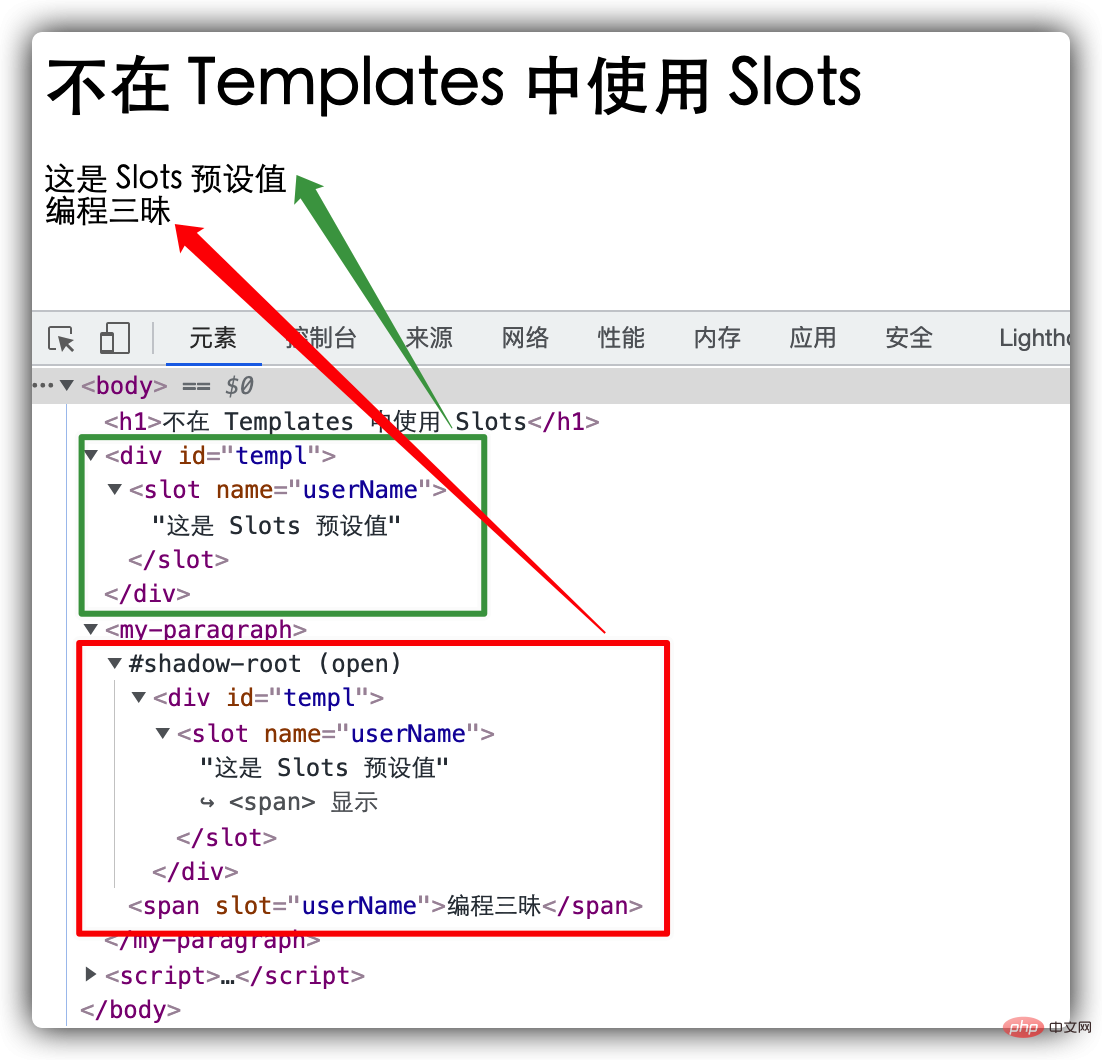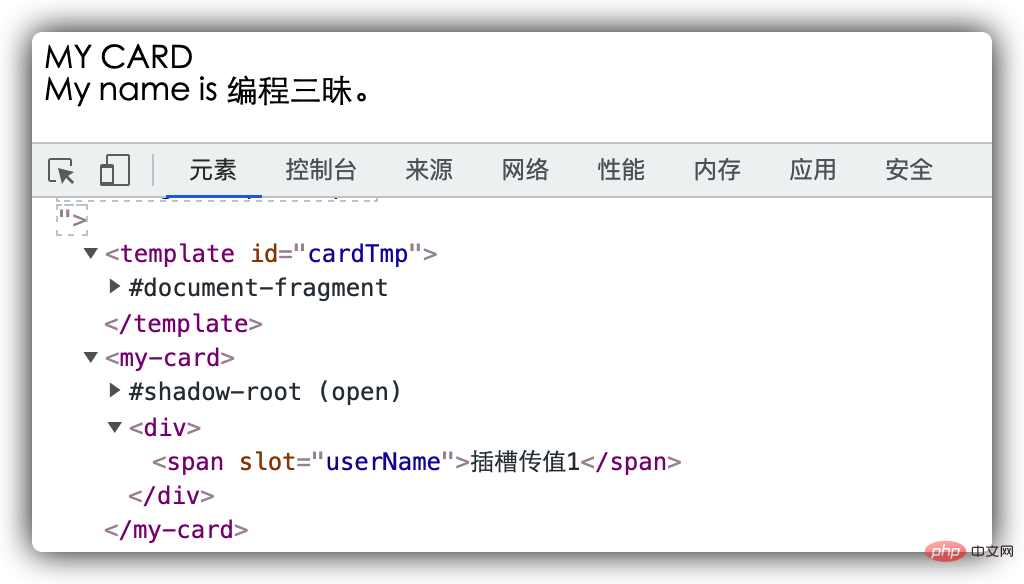一起聊聊Web Components之Slots(範例詳解)

熟悉 Vue 的同學應該都知道」插槽(slot)「的概念,通過使用插槽可以讓頁面內容的組織更加靈活。
在 Web Components 體系中也有插槽的概念,今天我們就來具體瞭解一下 Slots,本文主要包括以下內容:
- 為什麼要用 Slots ?
- Slots 的相關特性
Slots 的作用
我們首先來看一個模板元素:
<template>
<p class = "header">MY CARD</p>
<p class="details">
My name is 程式設計三昧。 </p></template>既然是模板,那就意味著在很多地方都會使用到它,但是,這裡會存在一個問題:所有使用這個模板的地方都將顯示模板中的內容,即並不是所有人的名字都叫 」程式設計三昧「。
在這種情況下,叫其他名字的人是沒法使用這個模板的,顯然,這就和使用模板的初衷相違背了,這個模板的使用範圍太過狹小,不存在通用性。
想要使得這個模板具有通用性,其關鍵點在於 .details 中顯示的內容是否具有通用性。
開動腦筋想一想,我們是不是可以將其中的」程式設計三昧「設為動態內容,誰使用這個模板,誰就傳入自己的名字。恰好, Slots(插槽)就可以實現這種效果,具體如下:
<!--在模板中使用 slot 進行佔位--><template id="cardTmp">
<p class="header">MY CARD</p>
<p class="details">
My name is <slot name="userName">程式設計三昧</slot>。 </p></template><!--在使用上面模板的自定義元素中給 slot 傳值--><my-card>
<span slot="userName">插槽傳值</slot></my-card><my-card>
<span slot="userName">web Components</slot></my-card>其對應的 JS 程式碼如下:
class MyCard extends HTMLElement {
constructor () {
super();
const template = document.getElementById('cardTmp');
const templateContent = template.content;
this.attachShadow({mode: 'open'}).appendChild(
templateContent.cloneNode(true)
);
}}customElements.define('my-card', MyCard);實現效果:

通過上面的例子,我們可以用一句話總結 Slots 的作用:Slots 的作用就是給模板元素傳值,增強模板元素的靈活性和通用性。
Slots 的相關特性
對於 Slots 的相關特性,我通過問答的形式逐一解釋。
Slots 的 name 屬性有什麼作用?
帶有指定 name 的 Slots 被稱為 」具名插槽「,name 是 slot 的唯一標識。
在引入插槽內容的元素上需要使用與 Slots.name 值相同的 slot 屬性。看下面的程式碼:
<template id="cardTmp">
<p class="header">MY CARD</p>
<p class="details">
My name is <slot name="userAge">19</slot>。 </p></template><my-card>
<span slot="userName">程式設計三昧</slot></my-card><my-card>
<span slot="userName">web Components</slot></my-card><script>
class MyCard extends HTMLElement {
constructor () {
super();
const template = document.getElementById('cardTmp');
const templateContent = template.content;
this.attachShadow({mode: 'open'}).appendChild(
templateContent.cloneNode(true)
);
}
}
customElements.define('my-card', MyCard);</script>執行效果:

因為傳入的 slot 屬性值和 Slots 的 name 屬性值對不上,所以 Slots 未被插入。
傳值時的 slot 屬性值必須和 Slots 的 name 屬性值保持一致。
不給 Slots 傳值會怎樣?
將上面兩個自定義元素 my-card 中的 span 元素去掉,不傳任何值,即改成這樣:
<my-card></my-card>
執行後的效果:

可以看到,如果不給 Slots 傳值,那麼 Slots 會顯示它自己預設的內容。
其實結合以上兩點,還可以得出一個結論:如果有參照 Slots ,那只有對應 name 的 Slots 內容會被顯示,其餘的 Slots 皆不顯示。
正常 DOM 中可以使用 Slots 嗎?
這裡的」正常 DOM「 是相對於 Shadow DOM 來說的,指的是頁面所在的檔案物件。
程式碼如下:
<slot name="userName">Slots 預設值</slot><p slot="userName">bcsm</p>
顯示如下:

總結:正常 DOM 中使用 Slots,它會直接渲染在頁面上,切不具備插槽效果。
Slots 是不是必須用在 Templates 中?
我們前面看到的例子中,Slots 是在 Templates 中,那是不是意味著 Slots 必須要用在 Templates 中才能生效呢?
因為已經驗證過在正常 DOM 中的 Slots 是無效的,所以我們在 Shadow DOM 中做個測試,程式碼如下:
<body>
<h1>不在 Templates 中使用 Slots</h1>
<p id="templ">
<slot name="userName">這是 Slots 預設值</slot>
</p>
<my-paragraph>
<span slot="userName">程式設計三昧</span>
</my-paragraph>
<script>
class MyParagraph extends HTMLElement {
constructor () {
super();
const template = document.getElementById('templ');
this.attachShadow({mode: 'open'}).appendChild(
template.cloneNode(true)
);
}
}
customElements.define('my-paragraph', MyParagraph);
</script></body>顯示效果如下:

從顯示效果上可以看到,將包含 Slots 的正常 DOM 節點在追加到 Shadow DOM 後,Slots 顯示傳入的值,也就是說 Slots 是生效了的。
總結:Slots 在 Shadow DOM 中就可生效,並非一定要用在 Templates 中。
一個自定義元素中可以使用多個同名 Slots 嗎?
看程式碼:
<template id="cardTmp">
<p class="header">MY CARD</p>
<p class="details">
My name is <slot name="userName">程式設計三昧</slot>。 </p></template><my-card>
<span slot="userName">插槽傳值1</span>
<span slot="userName">插槽傳值2</span></my-card><script>
class MyCard extends HTMLElement {
constructor () {
super();
const template = document.getElementById('cardTmp');
const templateContent = template.content;
this.attachShadow({mode: 'open'}).appendChild(
templateContent.cloneNode(true)
);
}
}
customElements.define('my-card', MyCard);</script>顯示效果:

結論:一個 Slots 可以接收多個傳入值,且都會解析顯示出來。
Slots 的傳值元素必須是自定義元素的直接子元素嗎?
上面的例子中,所有給 Slots 傳值的元素都是自定義元素的子元素,那是不是非直接子元素不行呢?
程式碼如下:
<template id="cardTmp">
<p class="header">MY CARD</p>
<p class="details">
My name is <slot name="userName">程式設計三昧</slot>。 </p></template><my-card>
<p>
<span slot="userName">插槽傳值1</span>
</p></my-card><script>
class MyCard extends HTMLElement {
constructor () {
super();
const template = document.getElementById('cardTmp');
const templateContent = template.content;
this.attachShadow({mode: 'open'}).appendChild(
templateContent.cloneNode(true)
);
}
}
customElements.define('my-card', MyCard);</script>執行效果(傳值失效):

結論:給 Slots 傳值的元素必須是自定義元素的直接子元素,否則傳值失效。
更多程式設計相關知識,請存取:!!
以上就是一起聊聊Web Components之Slots(範例詳解)的詳細內容,更多請關注TW511.COM其它相關文章!